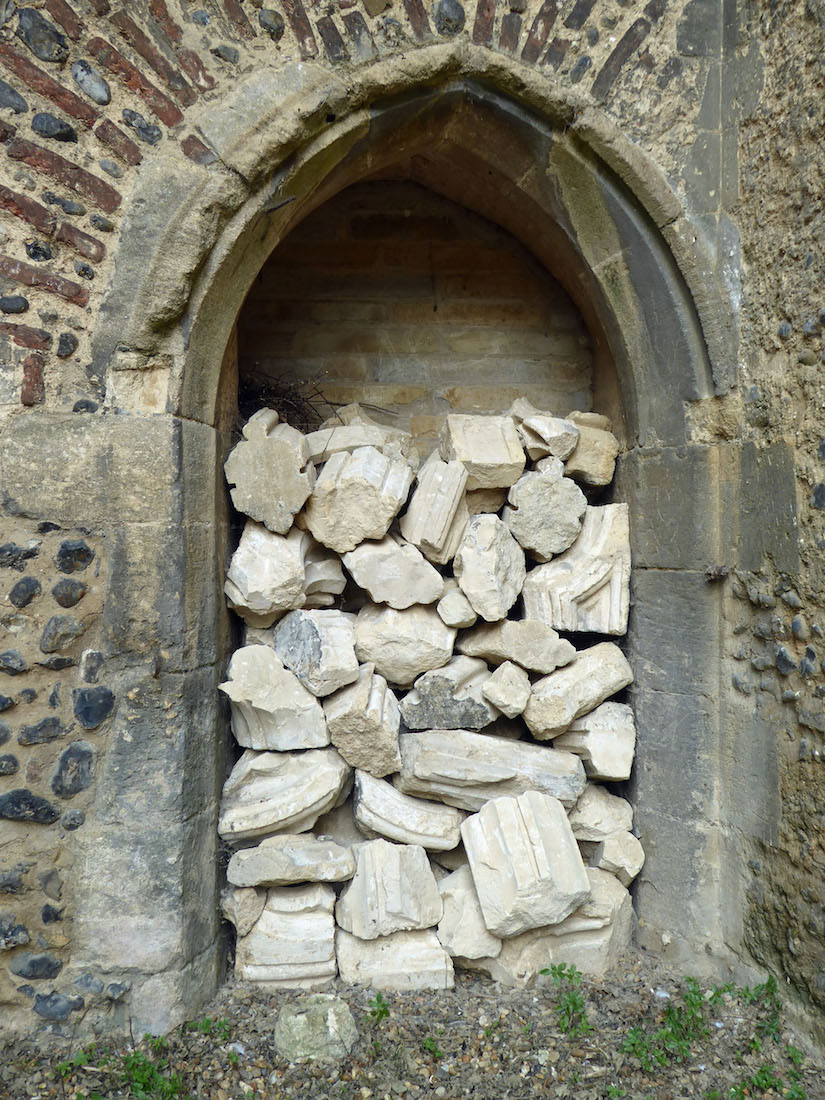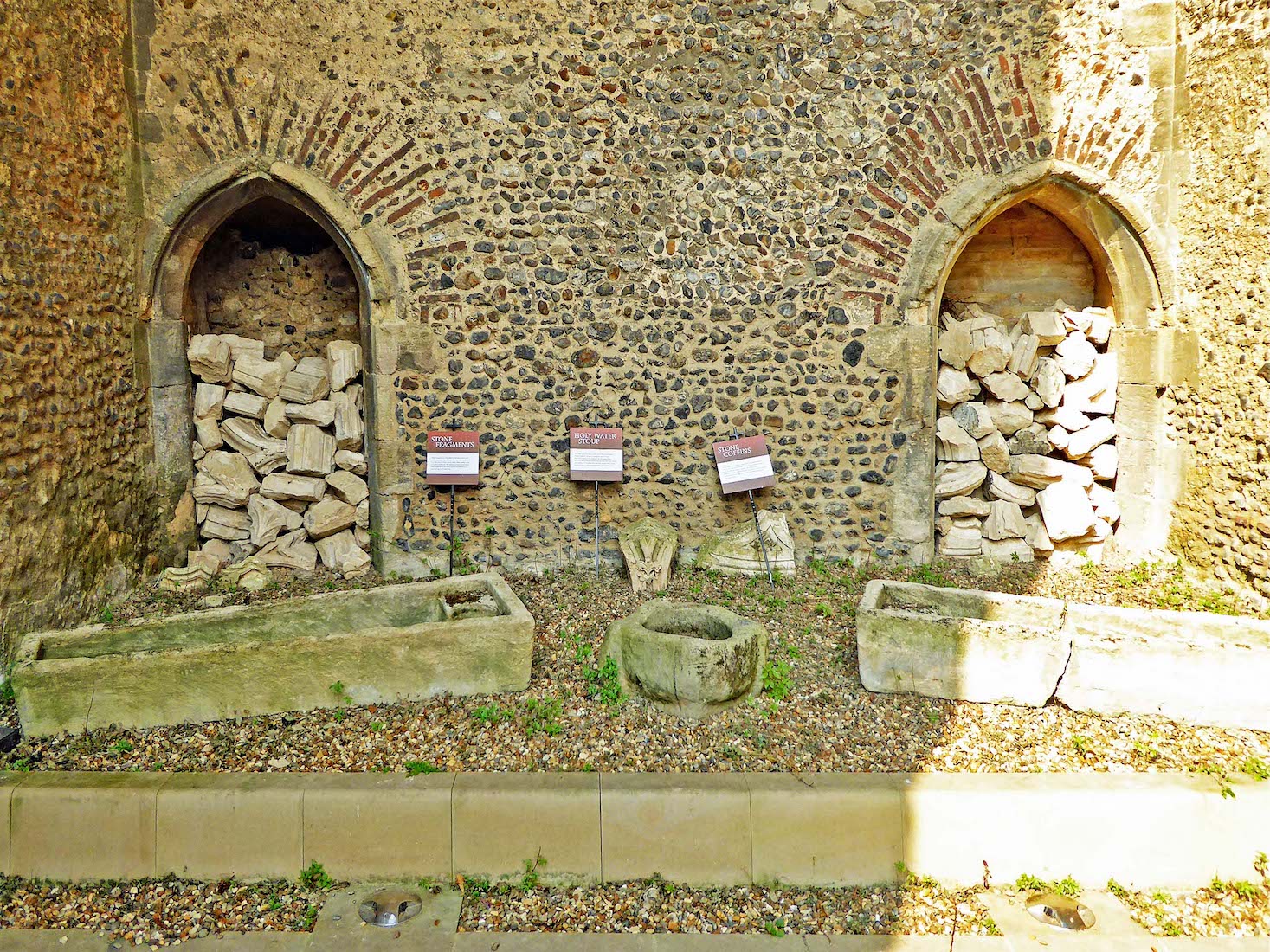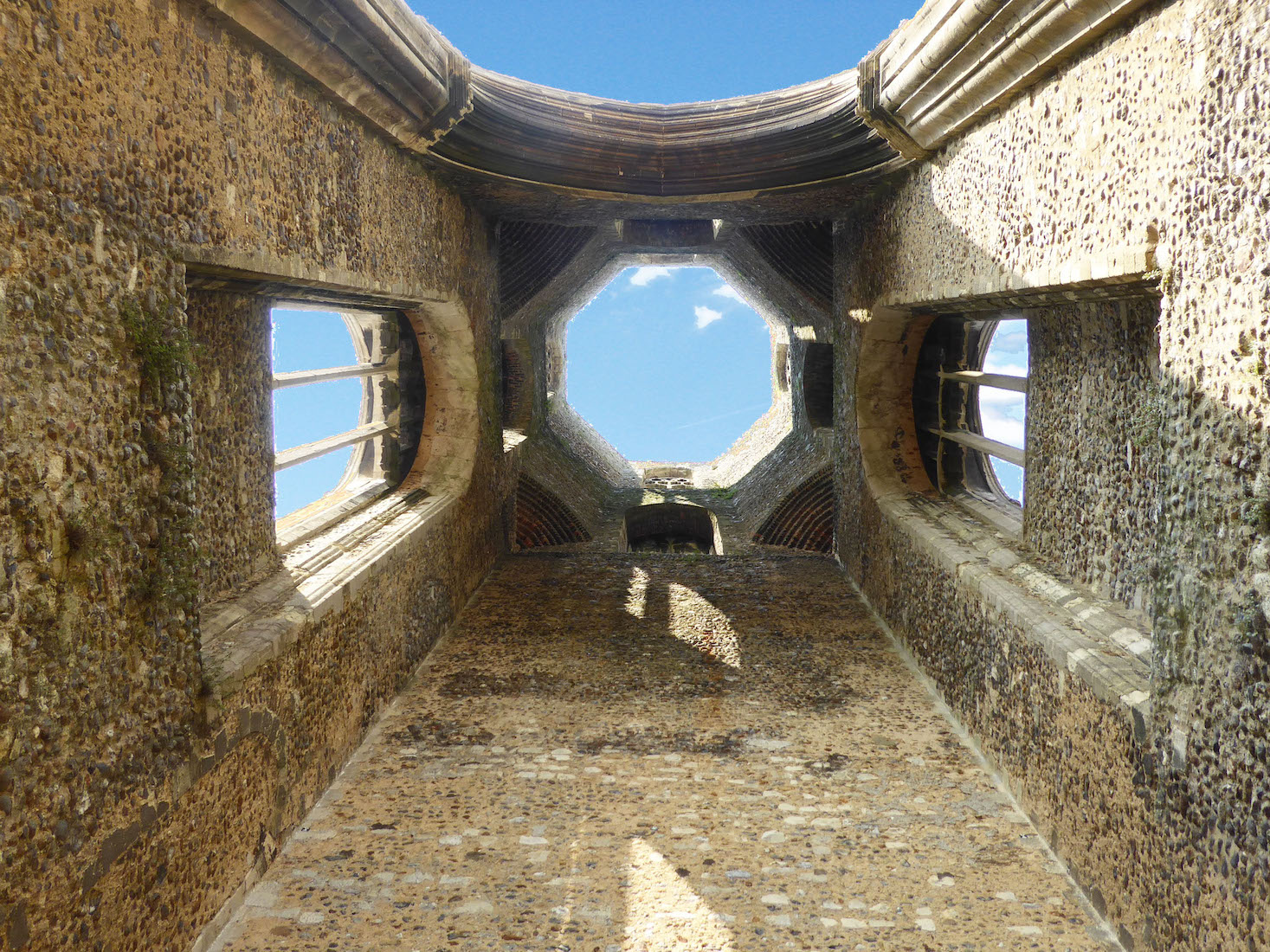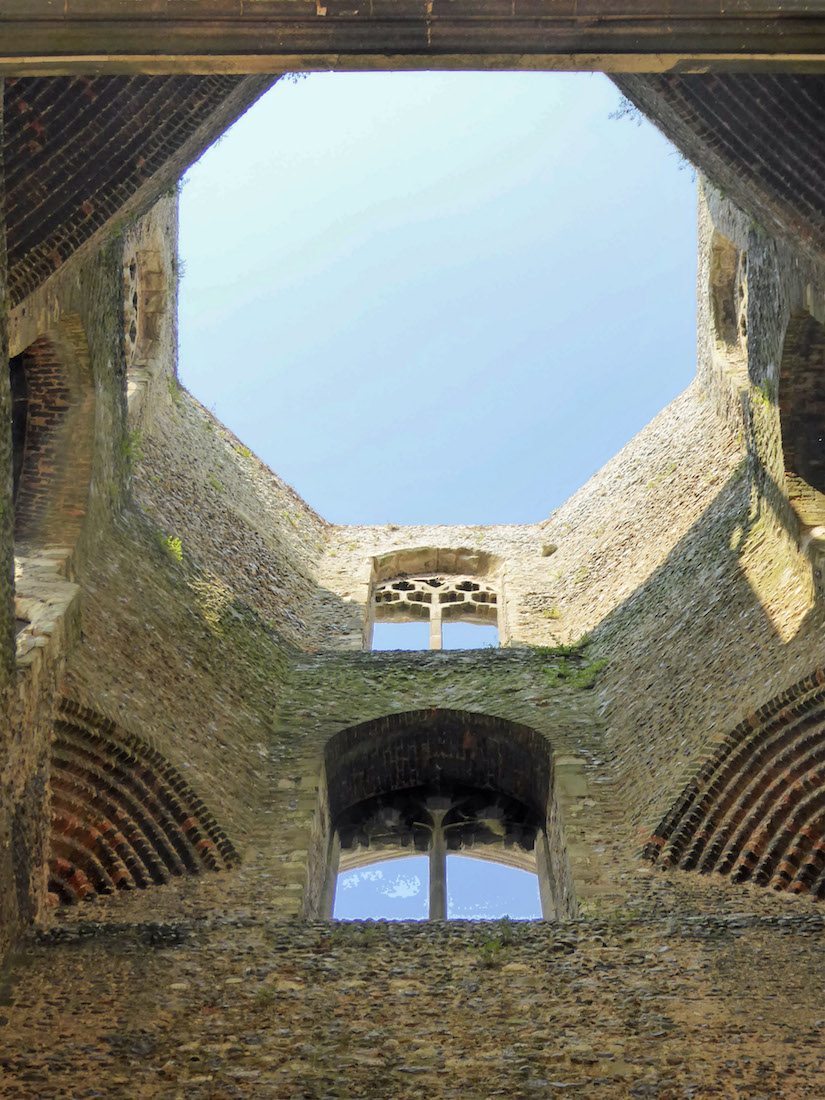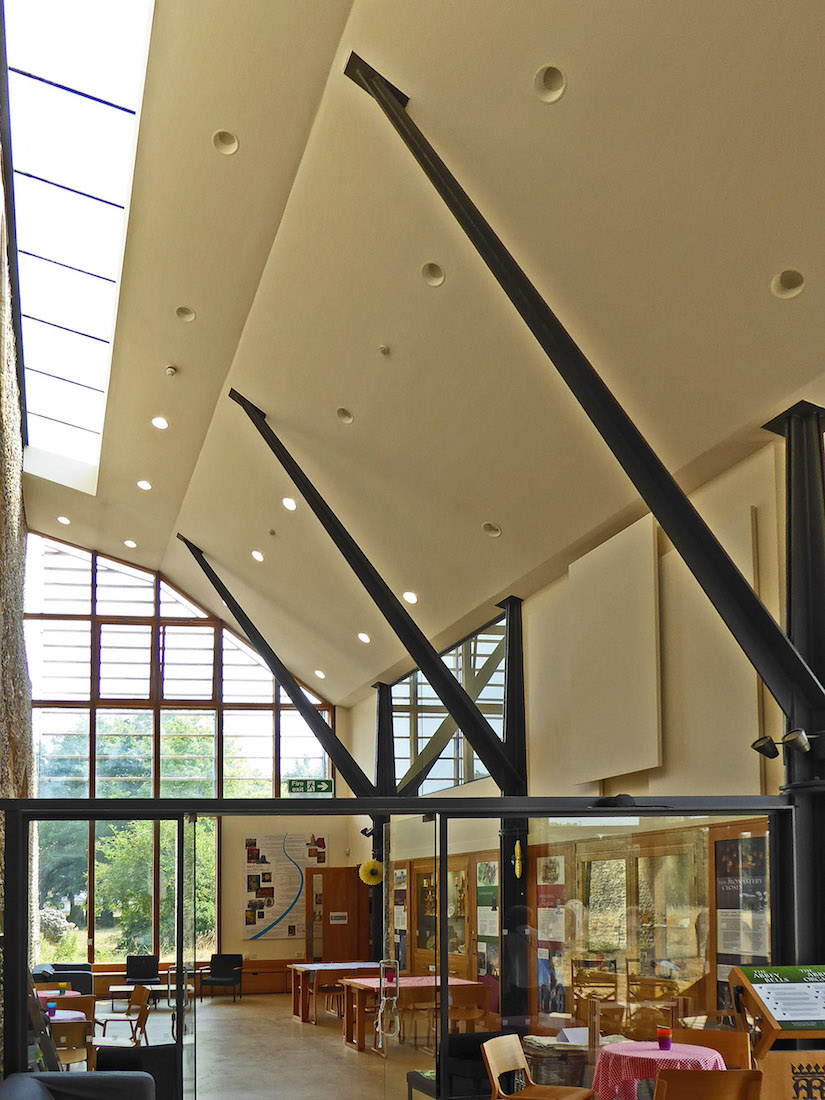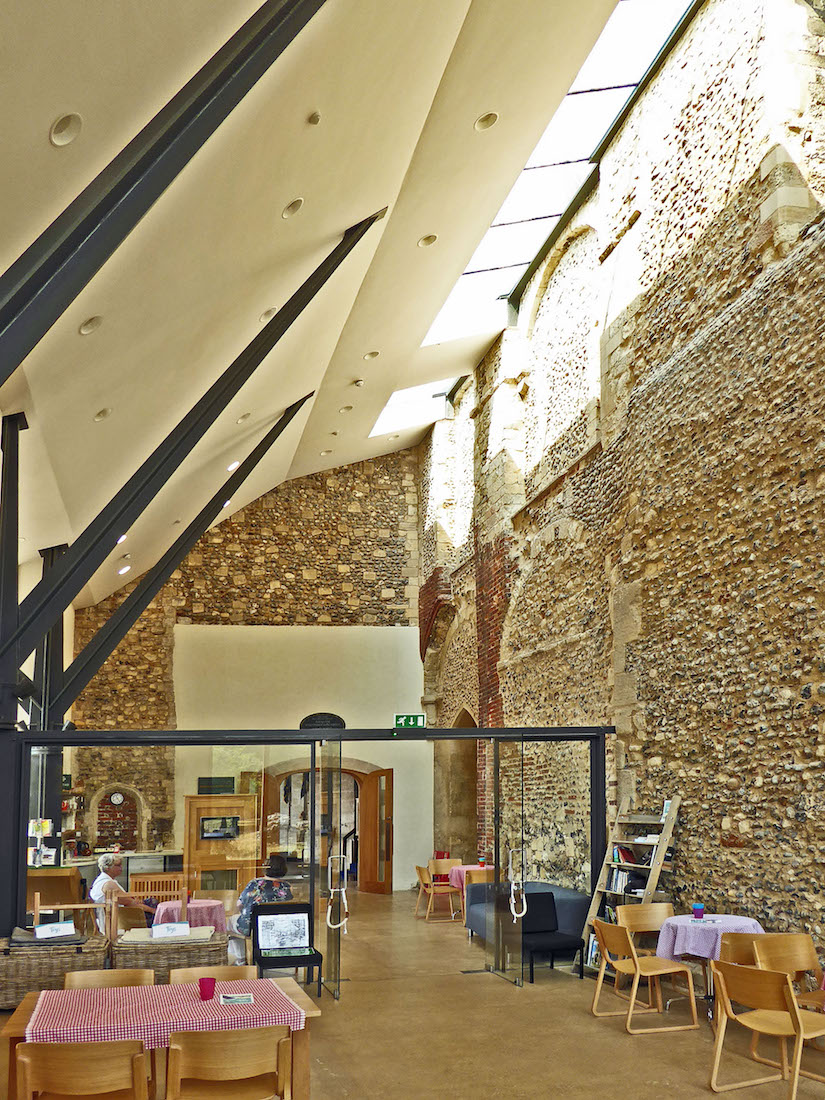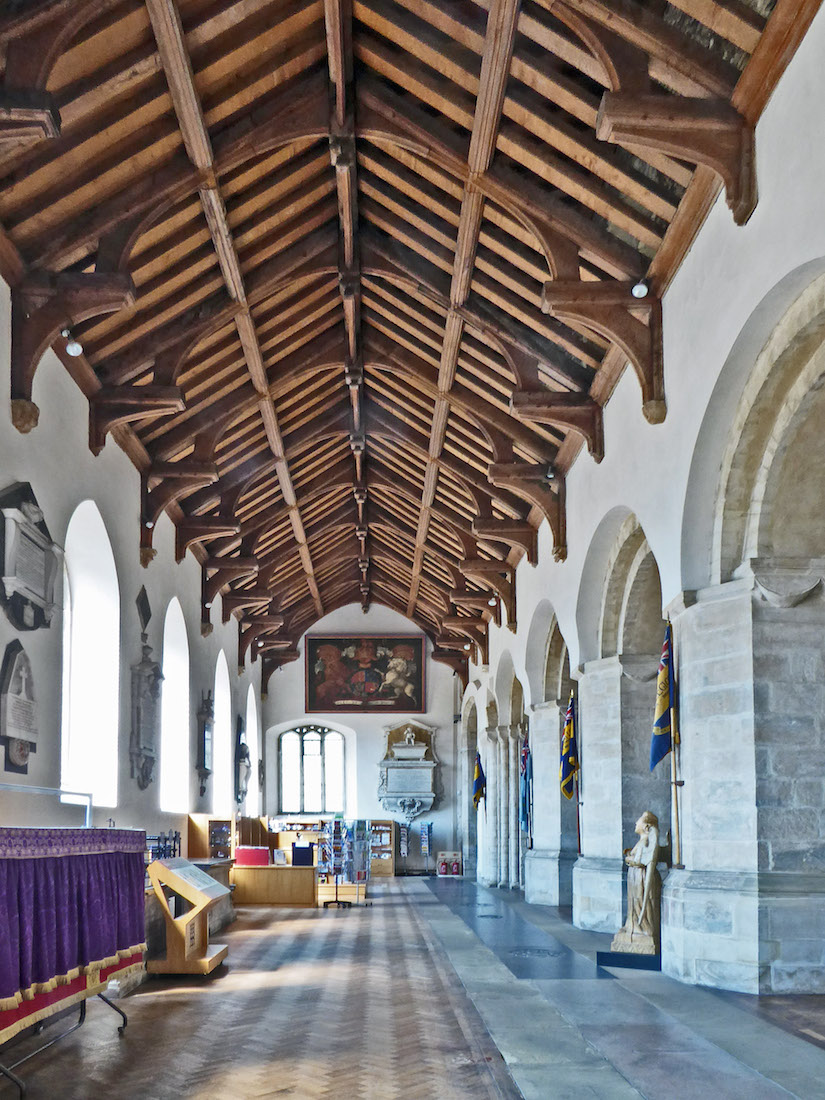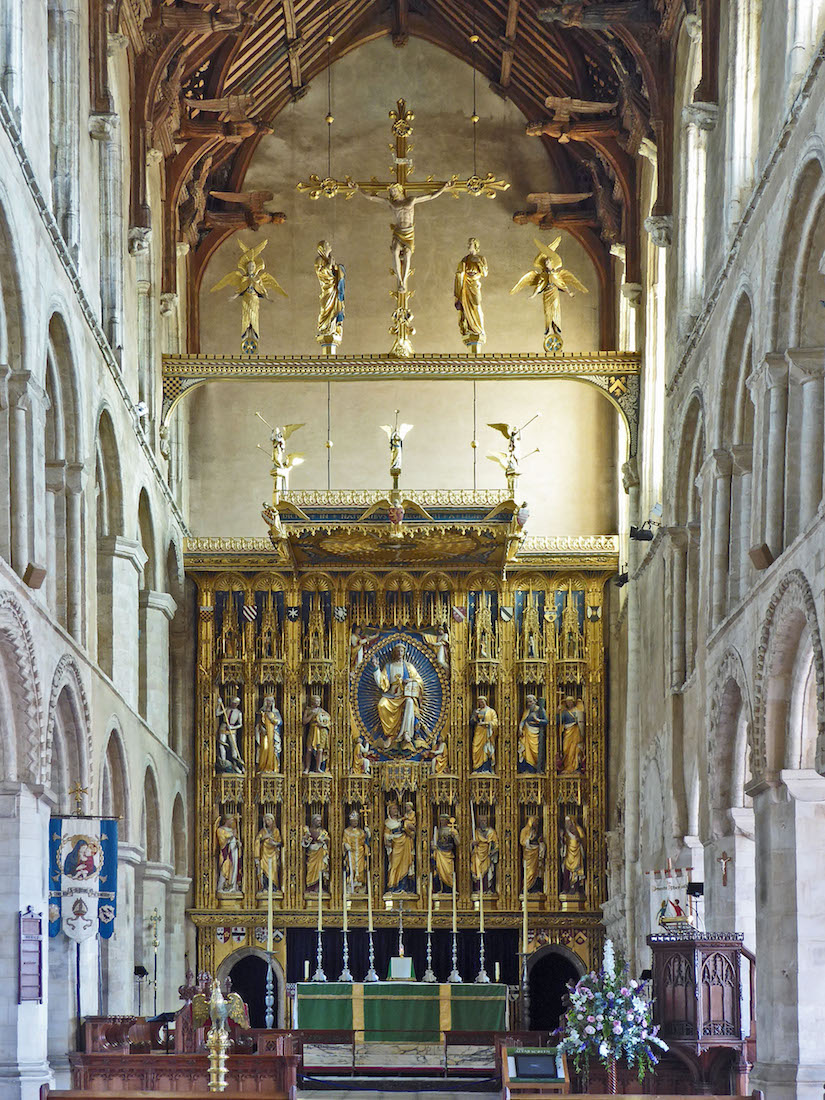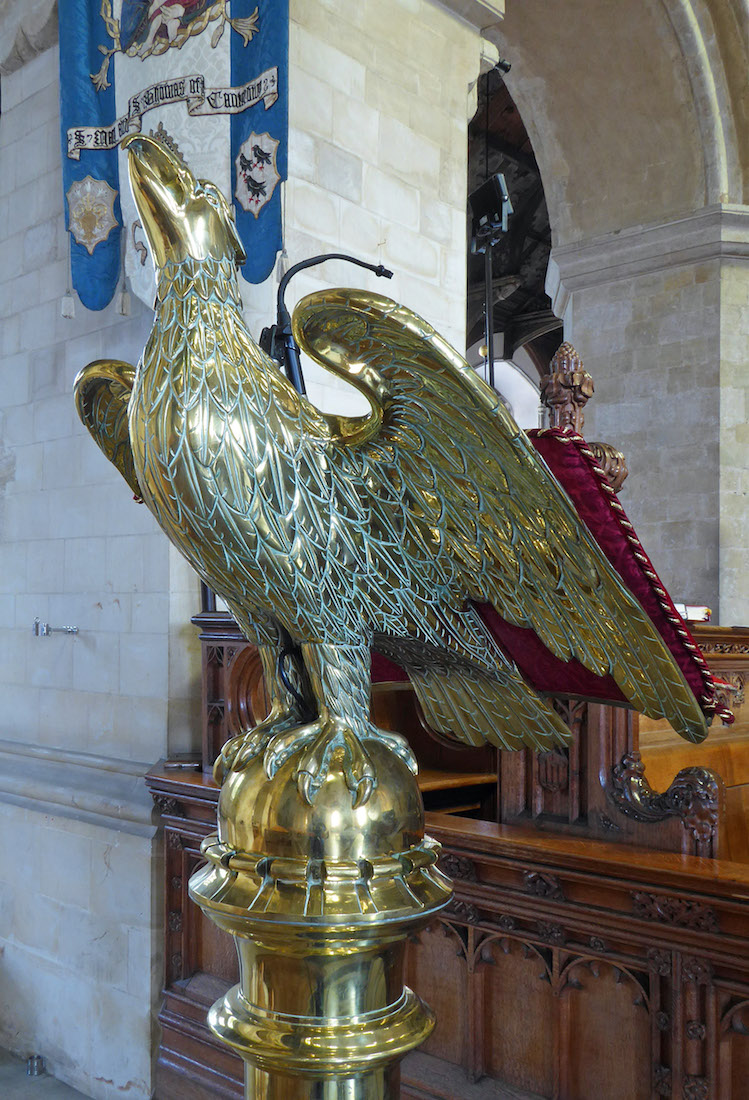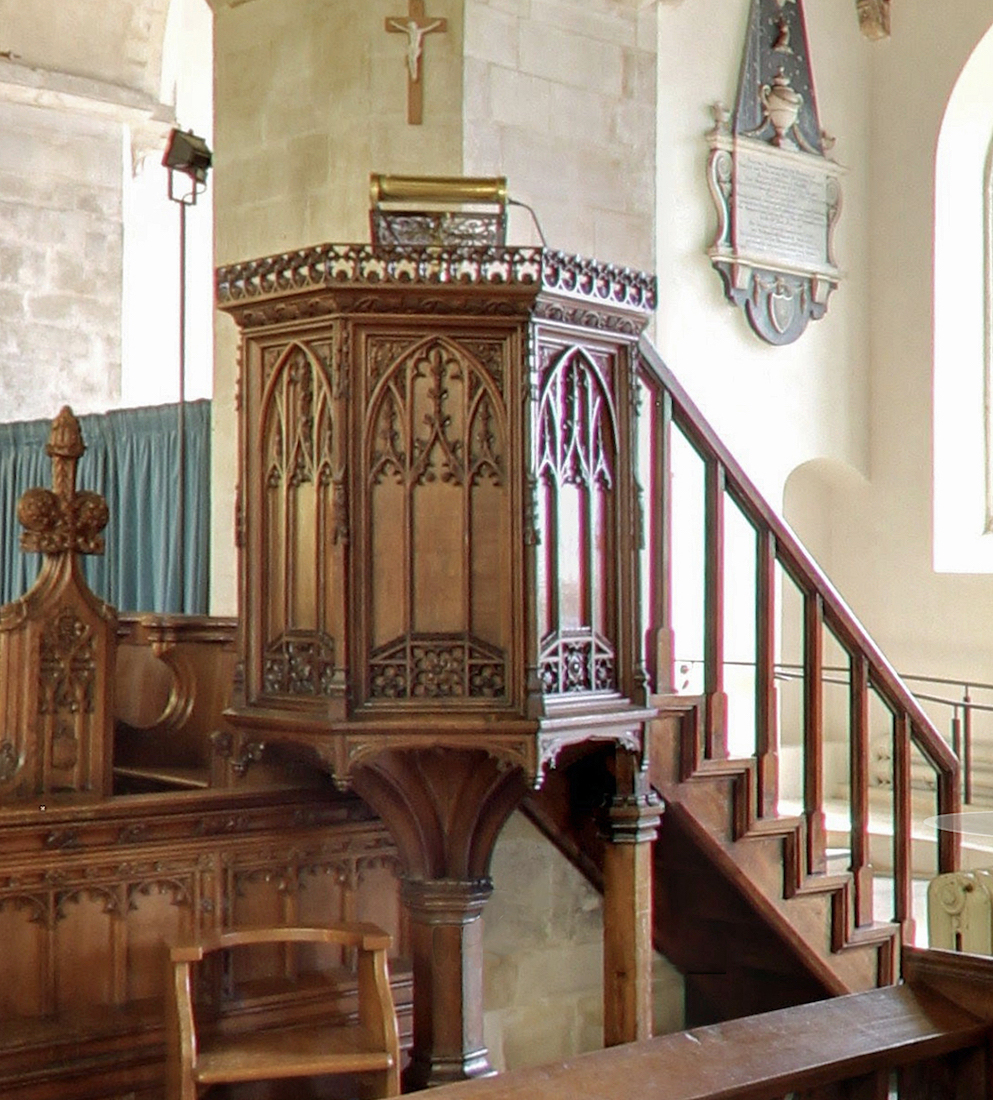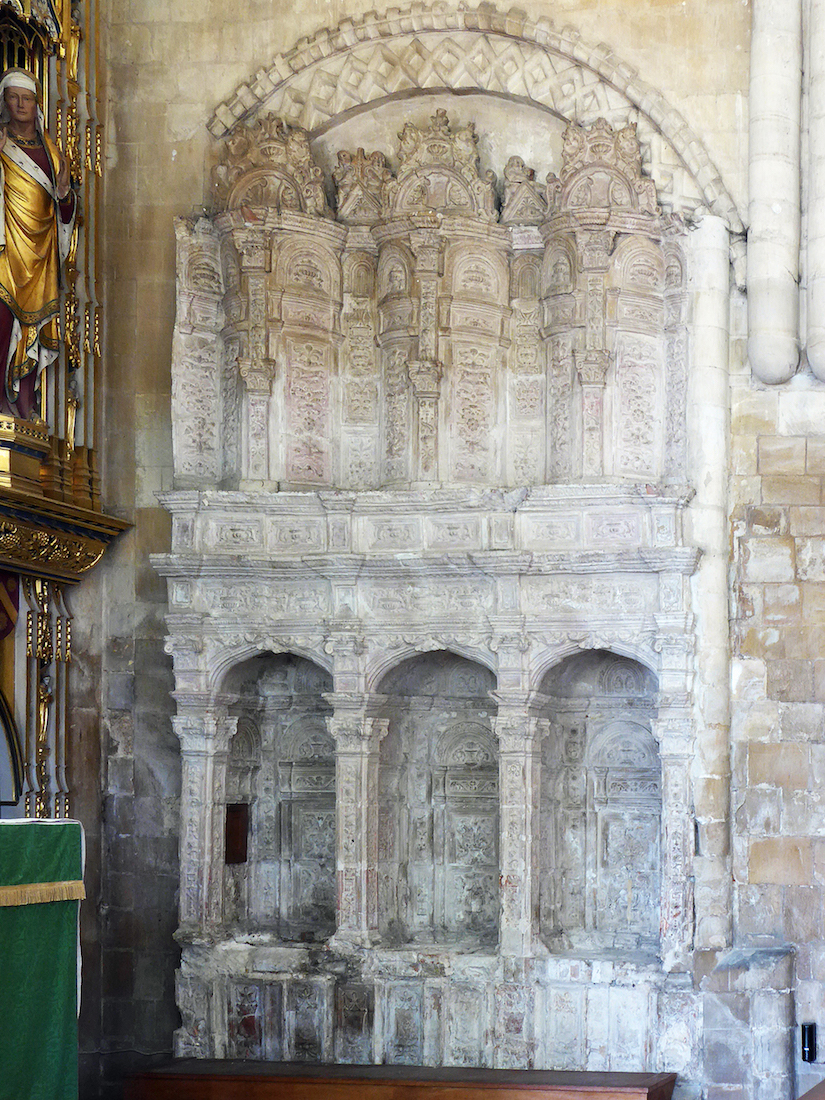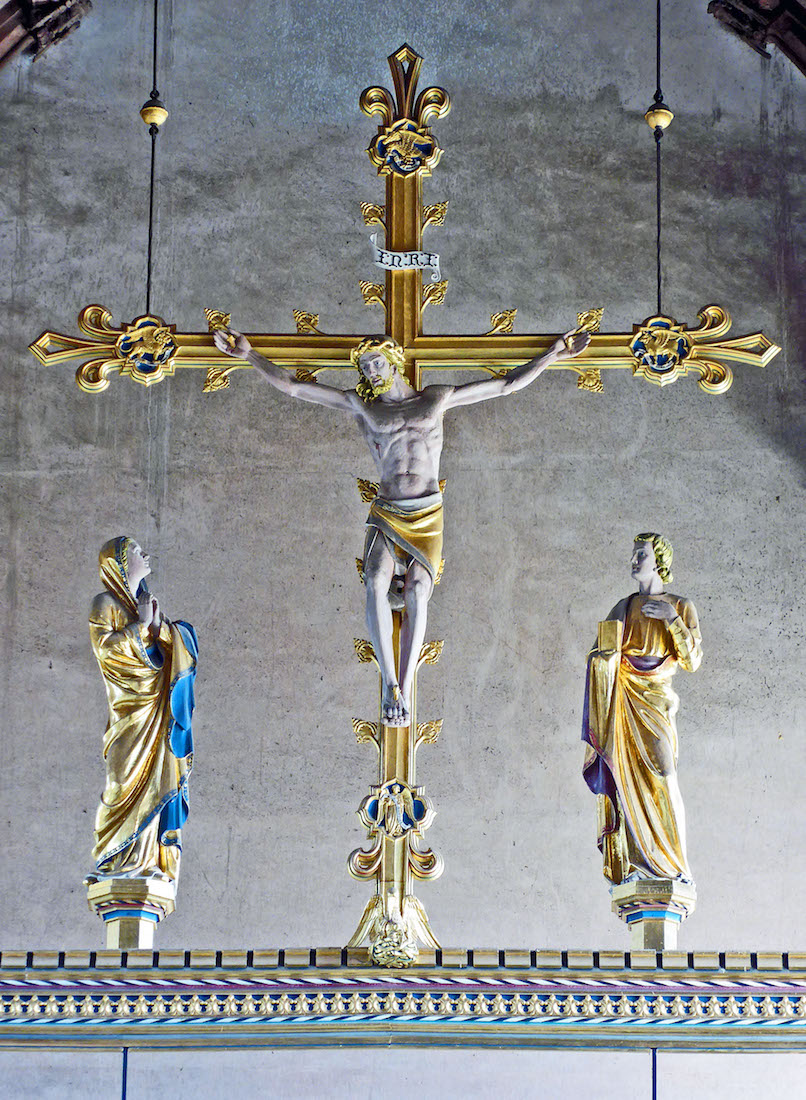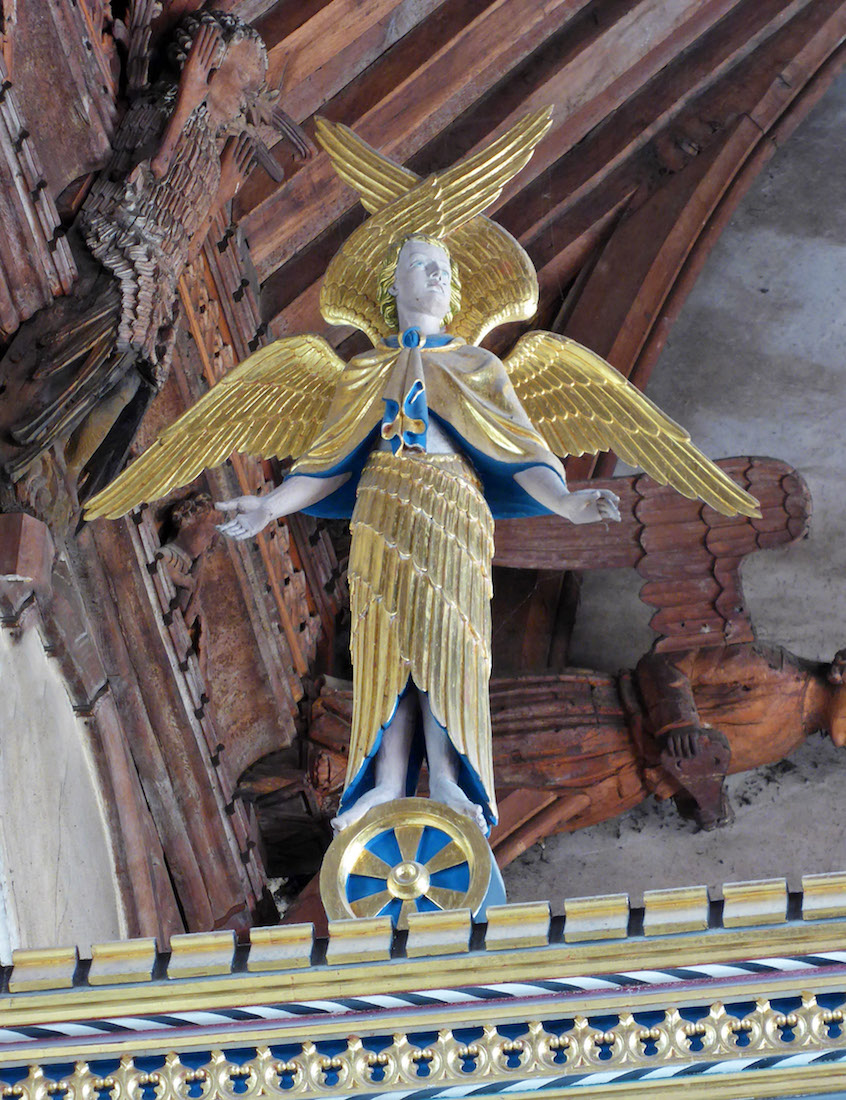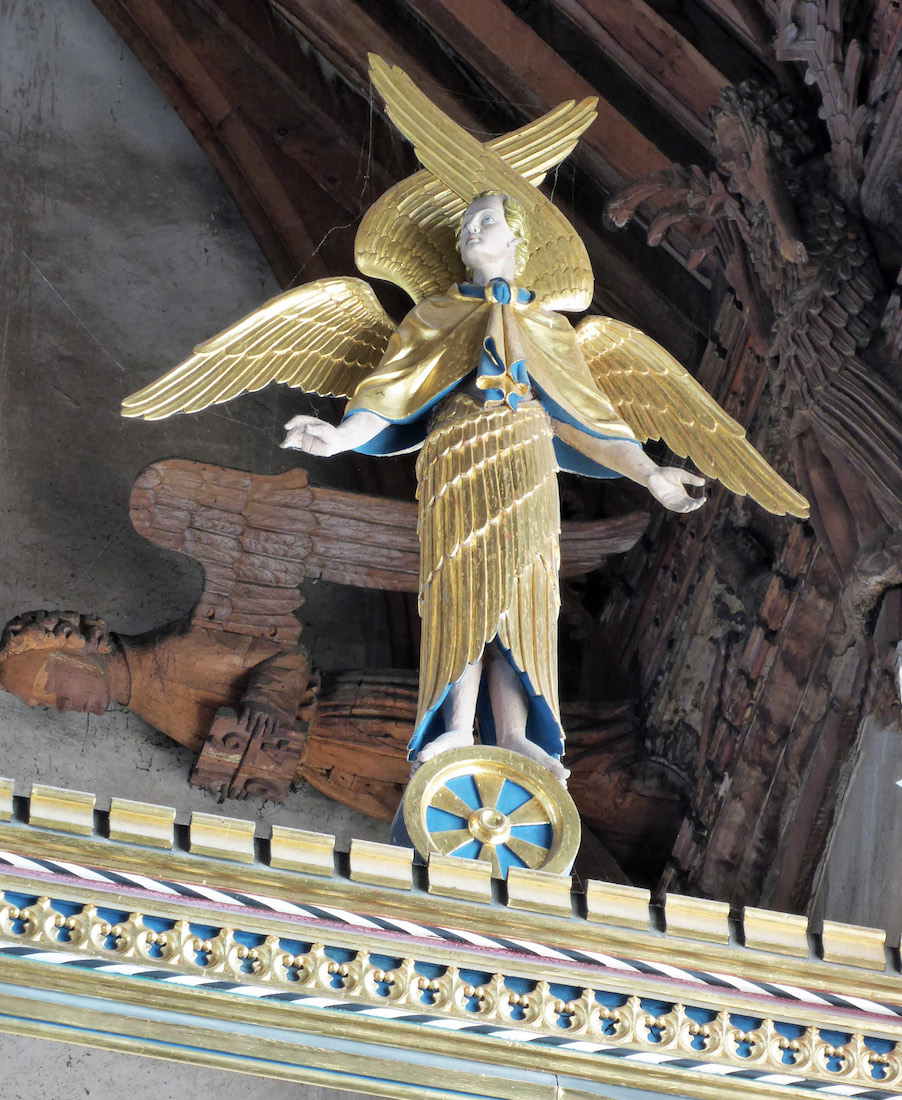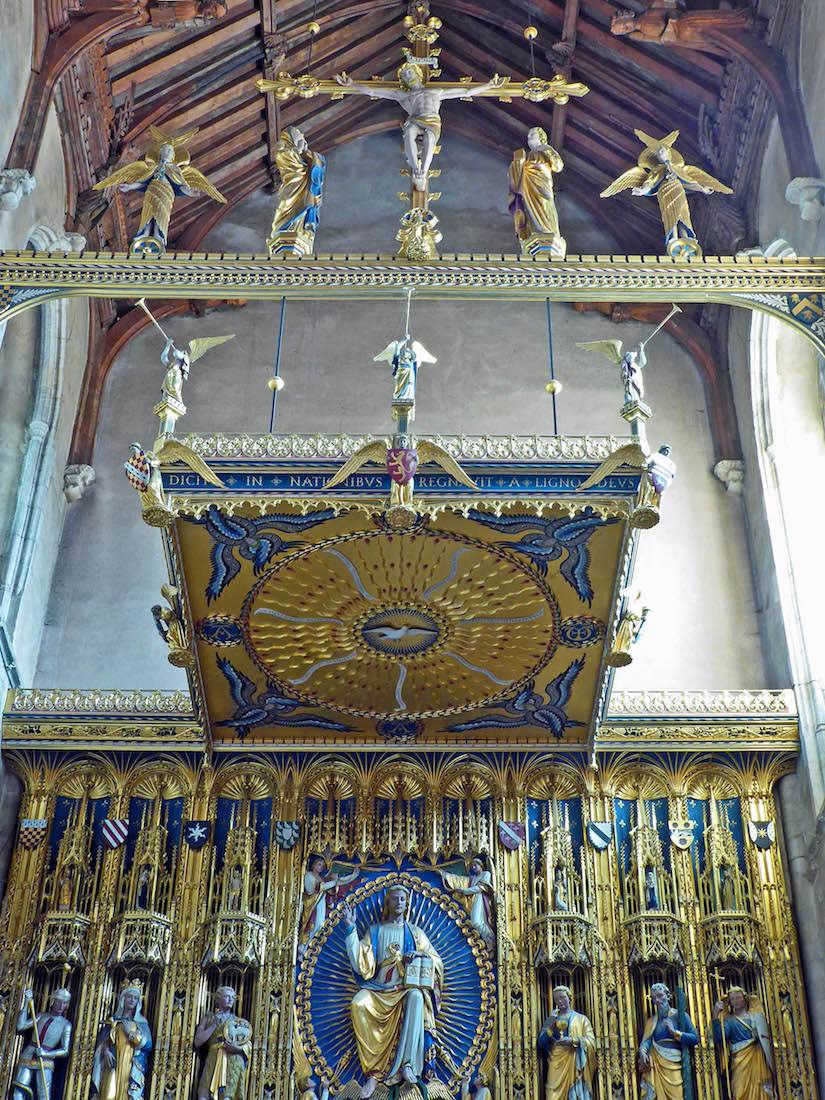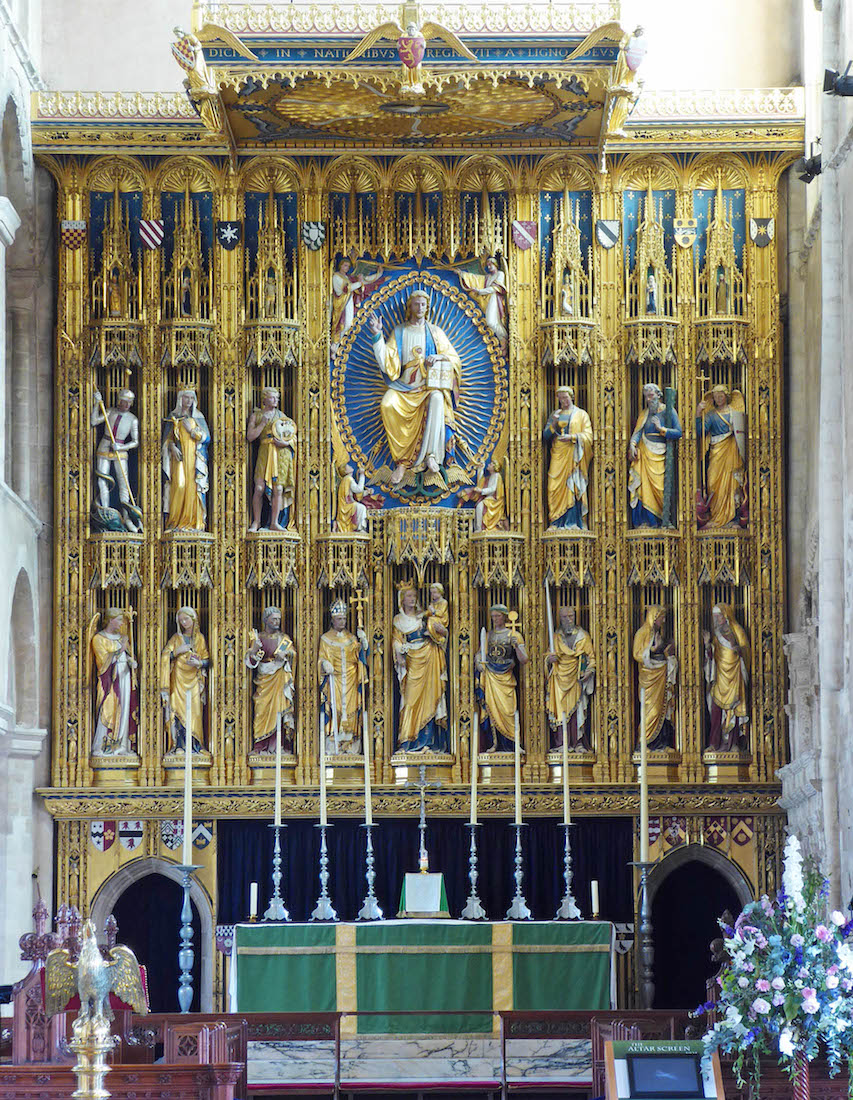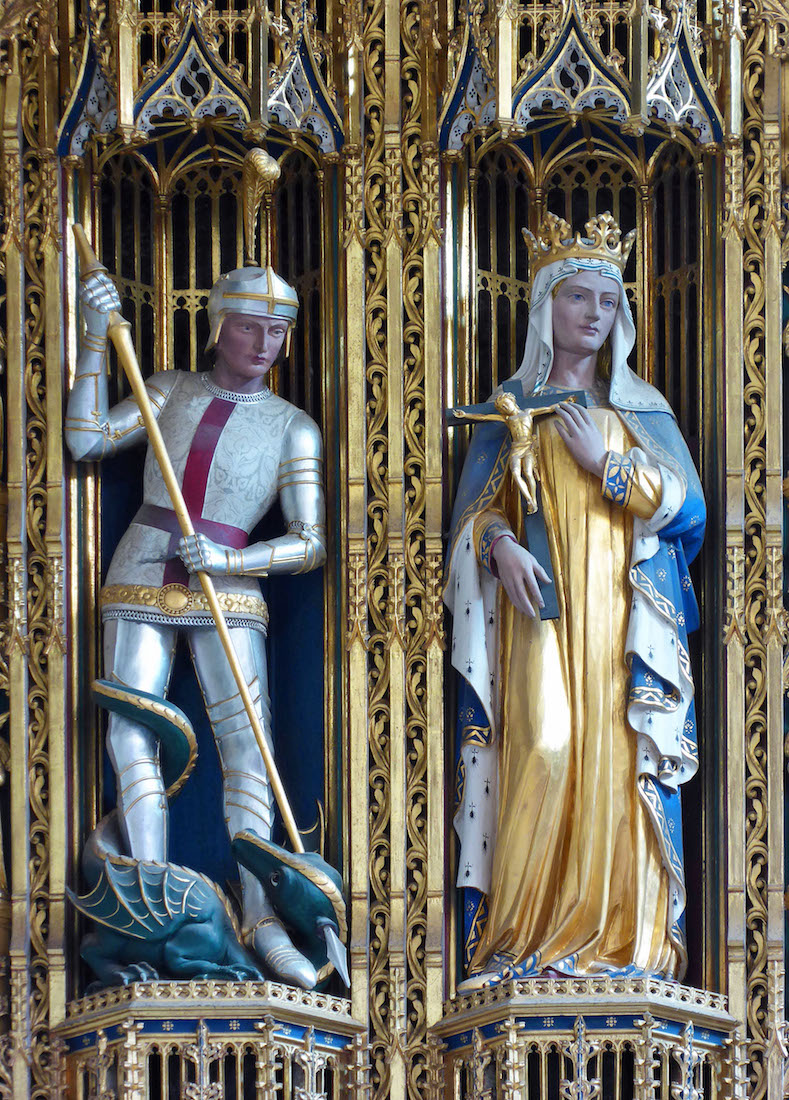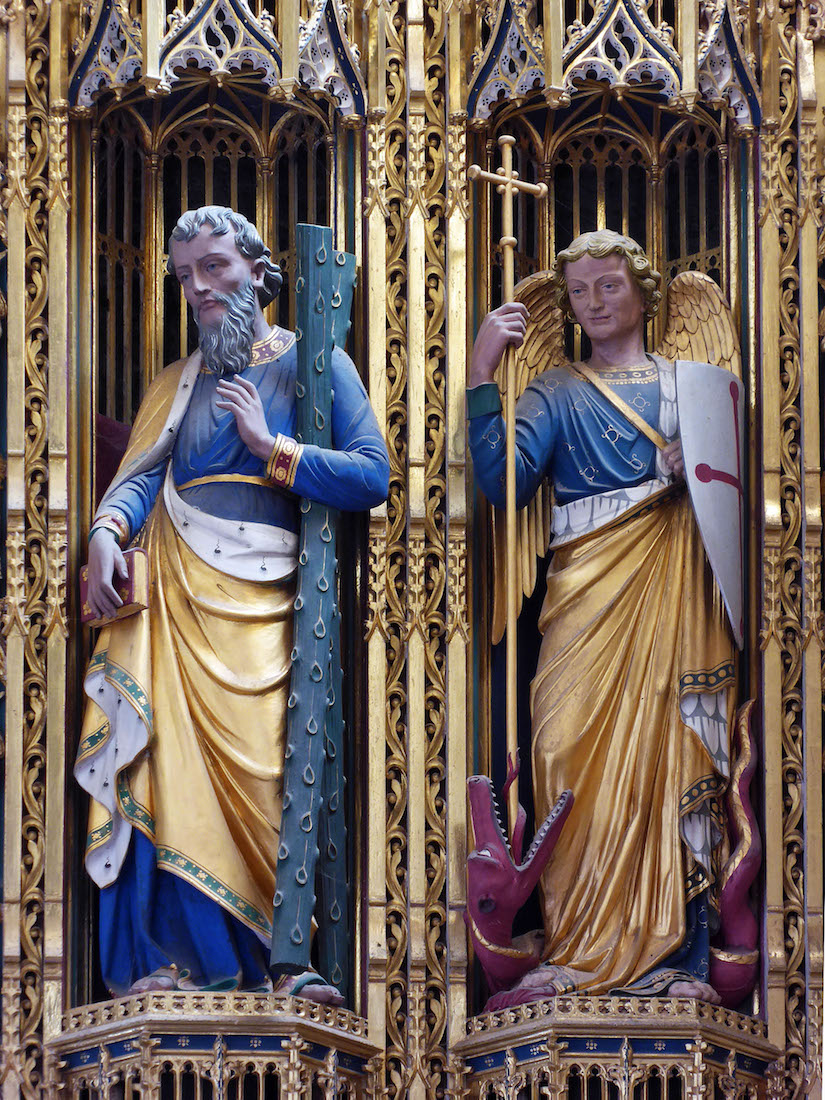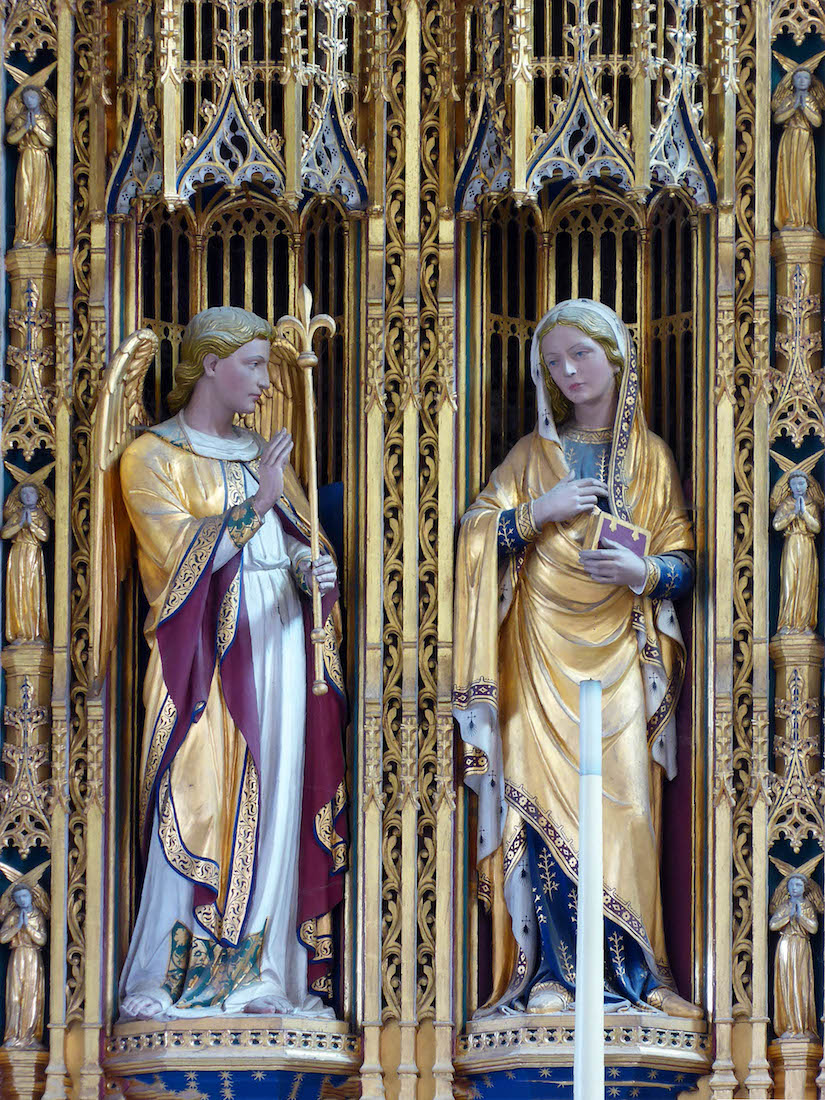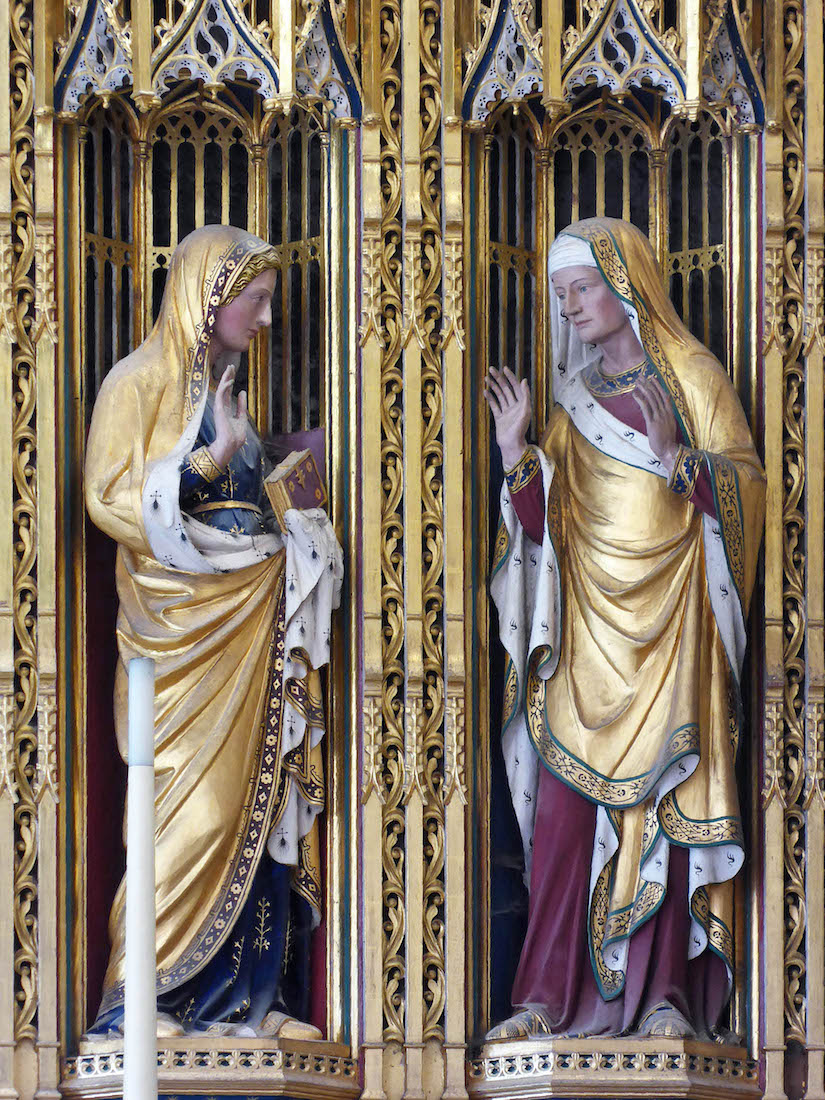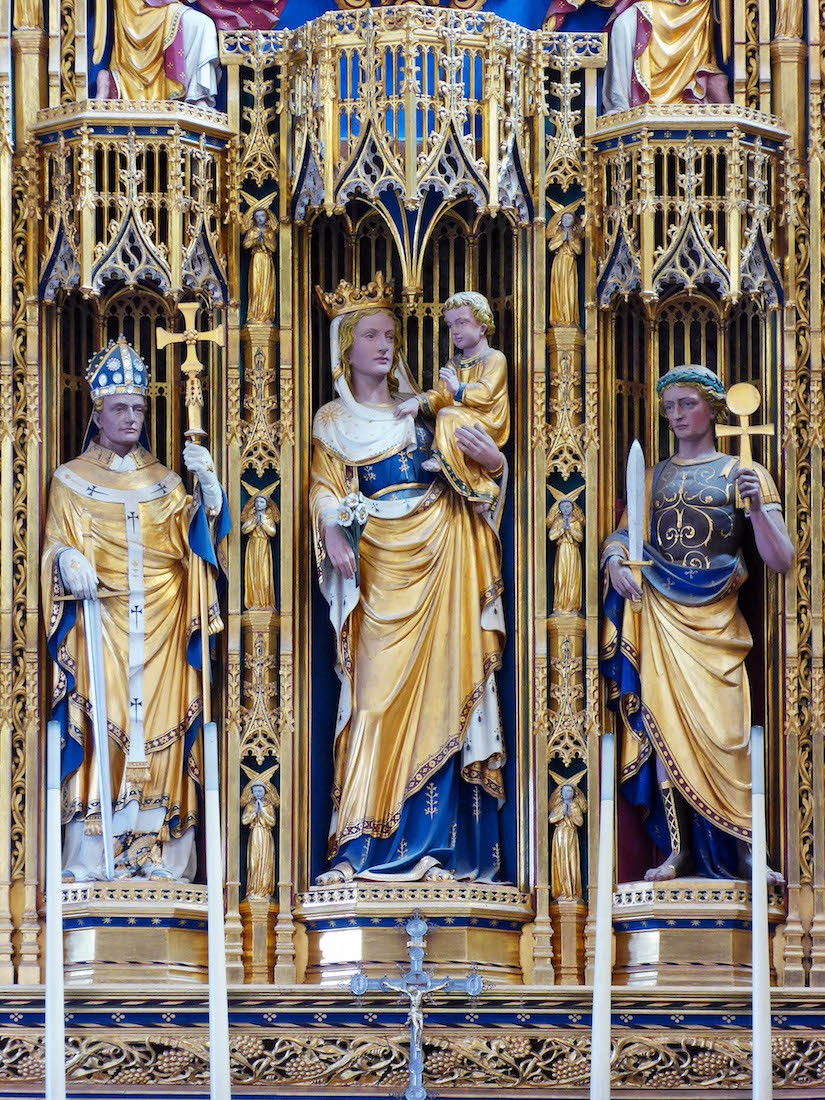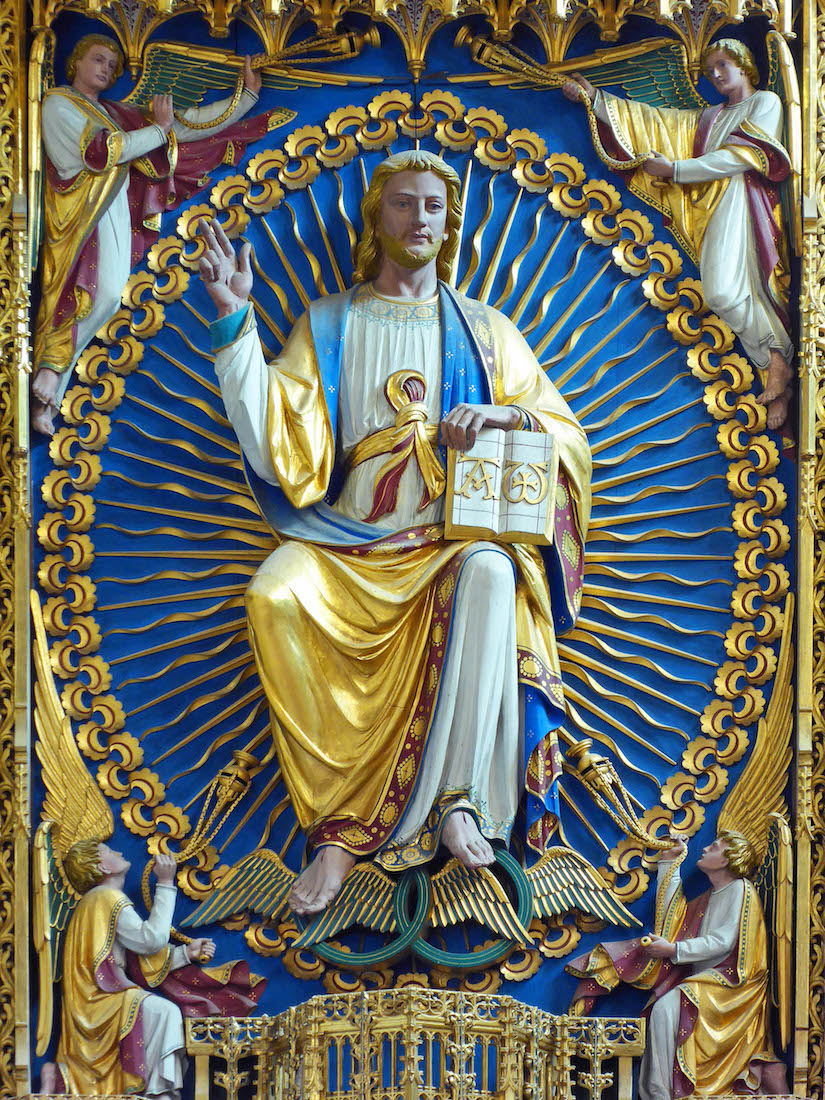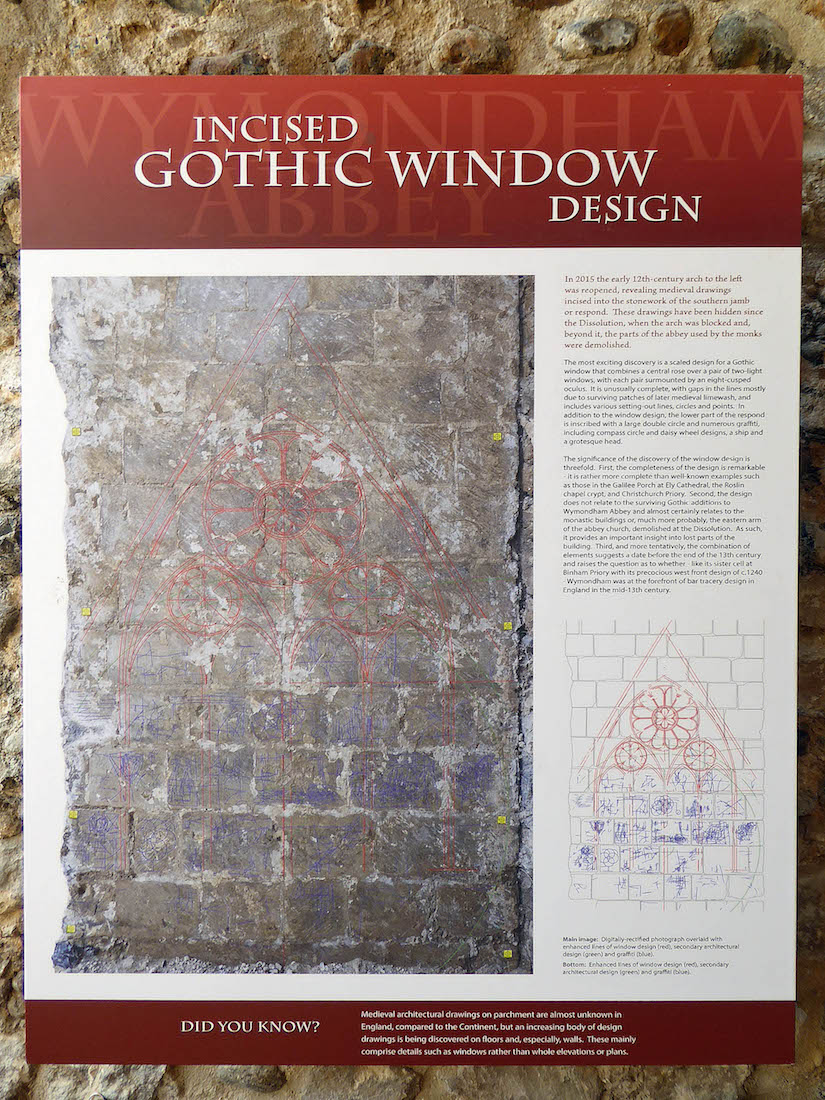
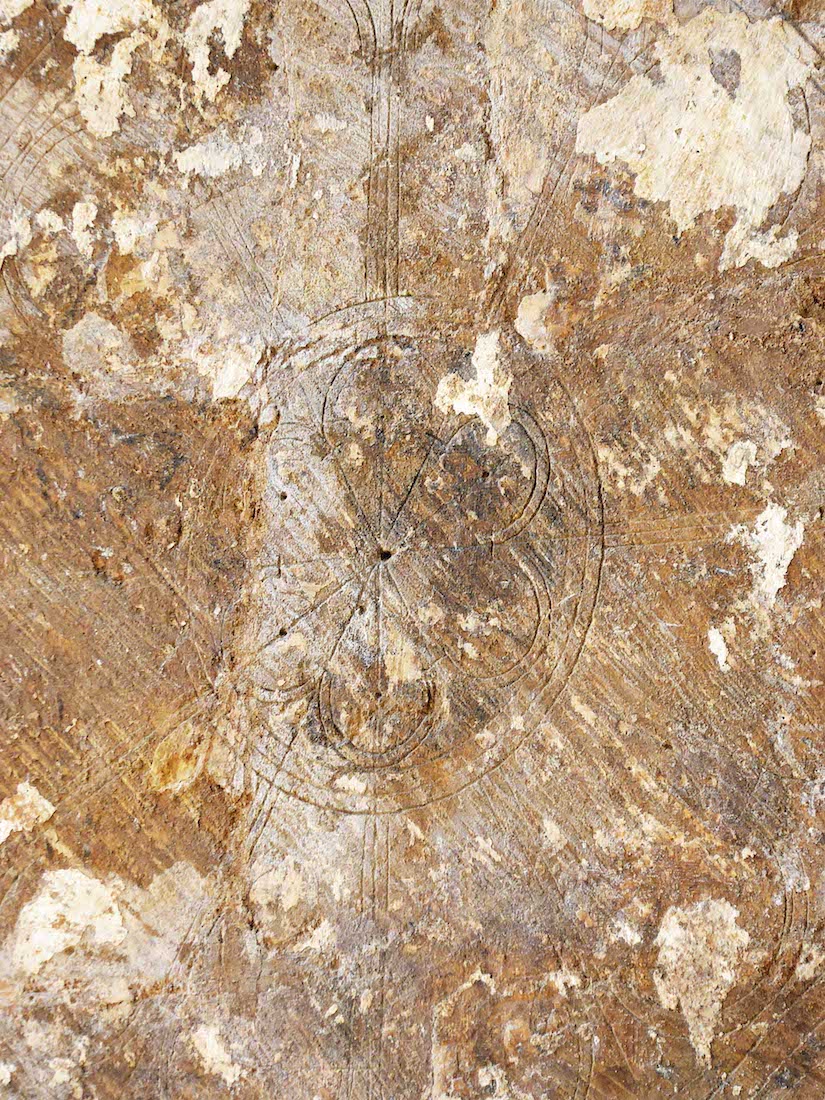
Near the corner of the vestry there is an information board with more information about the incised window, and shown at right is a close-up of that section of wall in which the design can be clearly seen. INDEX
42. PASSAGE WAY
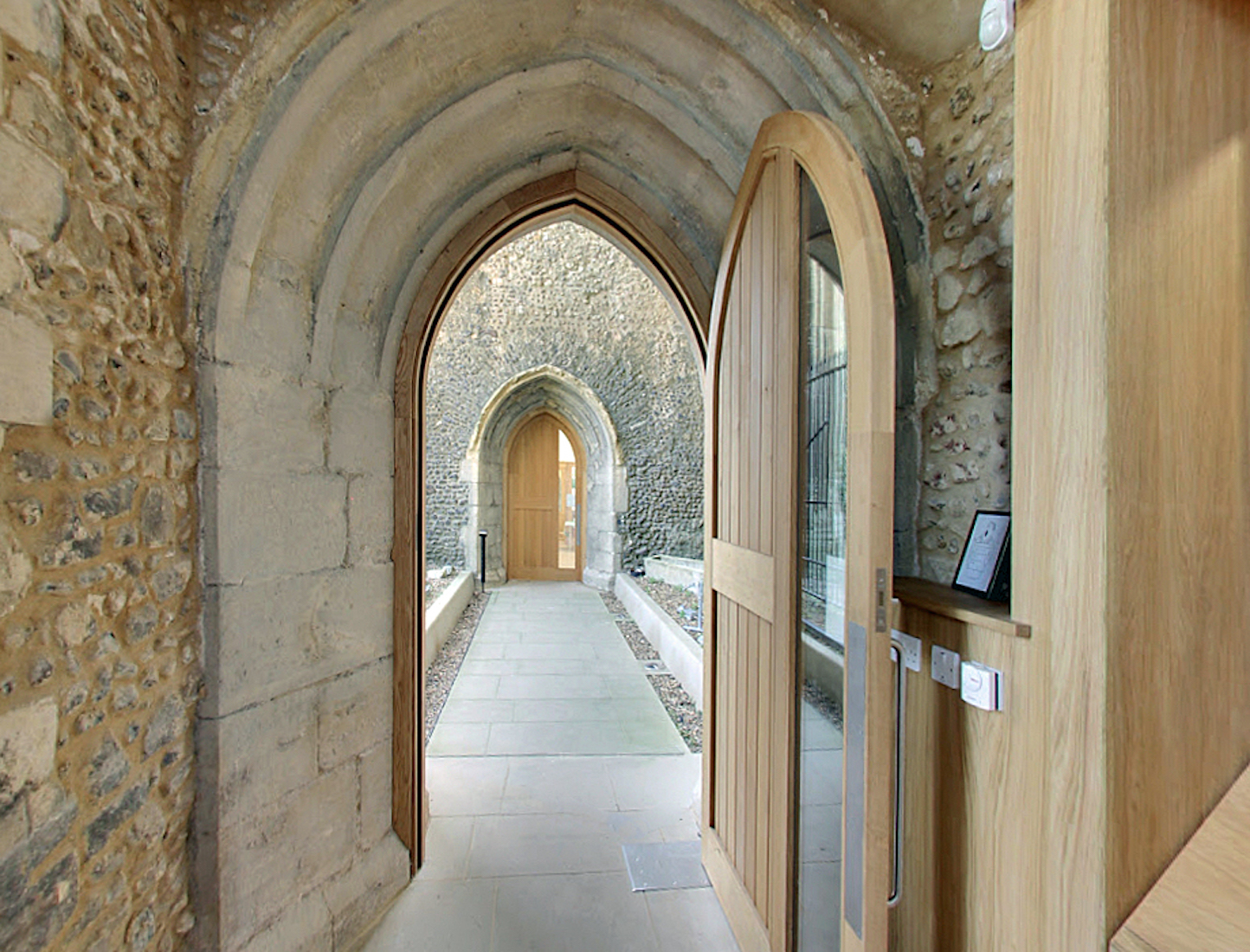
We leave the vestry, and make our way along the path linking the two new extensions. This passes through the base of the octagonal tower ruins.
43. BLOCKED DOORWAYS
To our right are some old remnants: some stone fragments, an old stoup, and two old stone coffins. The blocked doorways are on either side of the reredos in the central nave. When the Abbey was intact, these two doorways gave the only access between the East and West parts, and only the prior had the key.
44. OCTAGONAL TOWER
The original central tower was replaced in about 1376 by this tall octagonal tower which is now ruined. This tower held the monk’s bells.
45. TOWER
The octagonal tower ruins are a sad reminder of the destruction brought about by Henry VIII, but also of the long-standing dispute between the monks and the townspeople. So often in church politics the Christian ideals get lost!
47. CAFÉ AND KITCHEN
In the other direction, towards the nave, we find a modern kitchen and a place for refreshments. This is a lovely addition, ideal for taking a break. Toilet facilities are available here.
48. SOUTH AISLE LOOKING WEST
Leaving the Visitors’ Centre we emerge into the South aisle,and familiar territory. Tha angel is waiting for us!
50. LECTERN AND PULPIT
The eagle lectern is widely found in English churches and cathedrals: it is from here that the Scripture is read. The pulpit was newly erected in 1824, and removed from the South side to the centre of the nave in 1837. A handsome monument, on the South side of the altar, it is supposed to cover the remains of the last abbot, and is in various styles of architecture.
51. SEDILIA
Directly behind the pulpit in the chancel stands this early Tudor terracotta sedilia which dates from the 1530s. It is an historic part of Wymondham Abbey, but to me it seems something of a visual ‘intrusion’!
52. ROOD CROSS
High above the reredos is the elegant rood cross, depicting the crucified Christ with his mother Mary and disciple John looking on.
53. SERAPHIM
At the sides of the rood cross are two seraphim, heavenly beings described in Isaiah 6:3 as: ‘ each one had six wings; with twain he covered his face, and with twain he covered his feet, and with twain he did fly.’
54. TESTER
A tester is a structure placed above an altar or other speaking platform that helps to project the sound of the speaker. It is usually made of wood and can be beautifully decorated.
55. REREDOS
The impressive reredos (altar screen) was designed in 1913 in the Gothic style by Sir Ninian Comper and depicts tiers of saints around a Christ in Majesty. In the 1920s the Eastern end of the Abbey nave with it’s temporary blocking wall looked rather plain and mean compared to the surrounding architecture and was not a fitting setting for the high altar. Ninian Comper, on the recommendation of Sir William St John Hope, was called in to find a solution to the issue. His solution was to add to the wall an altar screen, with a tester and rood and it is one of his most monumental works. The main part of the work was completed in 1921, although the work of colouring and gilding the reredos was not completed until 1934. The inspiration for the altar screen was no doubt the surviving medieval examples at Winchester, St Albans and Southwark cathedrals.
56. SAINTS
There are various saints featured on the reredos, including (from left), St George, St Helena, St Andrew and Archangel St Michael. These are all well known, except perhaps St Helena. Flavia Julia Helena (AD c. 246/248 – c. 330), or Saint Helena, was the mother of Roman emperor Constantine the Great. She was born outside of the noble classes, a Greek, possibly in the Greek city of Drepana, Bithynia in Asia Minor. Helena ranks as an important figure in the history of Christianity and of the world due to her influence on her son.
57. ANNUNCIATION AND VISITATION
As well as the various saints on the reredos, there are also Biblical encounters incuding those shown here: The Annunciation, in which the angel Gabriel appears to Mary to foretell the birth of Jesus, and The Visitation,in which Mary goes to visit her cousin Elizabeth.
58. VIRGIN AND CHILD
At the bottom centre of the reredos, we have a crowned Mary holding the baby Jesus. I have no information on the side figures. Notice the exquisite little figures between the niches.
59. RISEN CHRIST
At the centre of the altar screen is the figure of the Risen Christ surrounded by worshipping angels. His right hand is raised in blessing, and he carries a book with the symbolic letters Alpha and Omega (the First and the Last, the Beginning and the End) as described in the Book of Revelation 22:13. This completes our tour of the Wymondham Abbey Church.
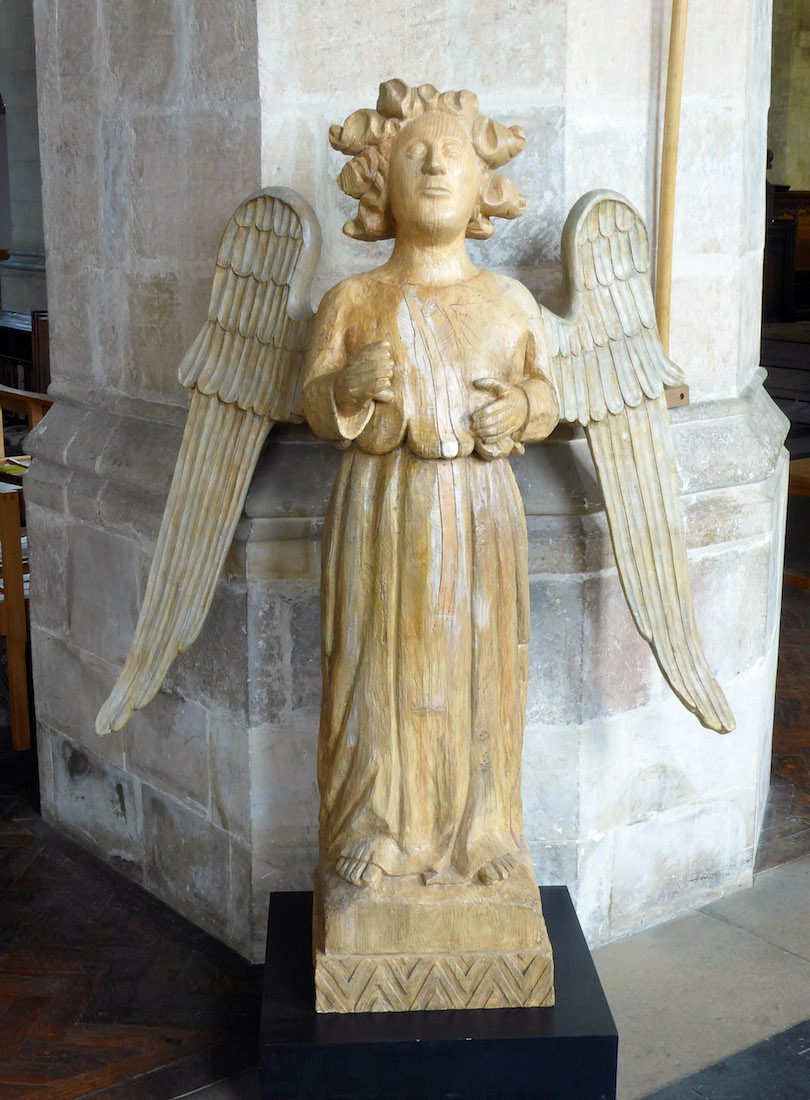
CONCLUSION
I hope you have enjoyed our visit to the Wymondham Abbey. What an interesting adventure it has been!
As mentioned earlier, all the photographs which appear here, apart from half a dozen which have special acknowledgement, are by Aidan McRae Thomson, and I am very grateful to Aidan for his support of this project.
I take little credit for the text which comes from a variety of different sources.
I also express my thanks to my wife Margie who dutifully reads through all my websites and checks the typing.
Wymondham Abbey has its own website with link:
http://www.wymondhamabbey.org.uk
The originals of Aidan’s photographs can be found at:
https://www.flickr.com/photos/amthomson/albums/72157718030429936
Site created 02 / 2021
Paul Scott

